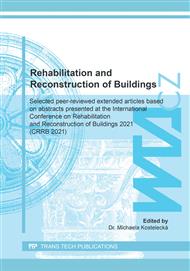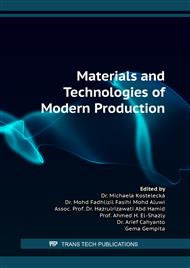p.173
p.179
p.185
p.191
p.197
p.205
p.213
p.219
p.225
Resistance of Electrically Conductive Concrete to Sulphate Attack
Abstract:
It was defined that structural elements of a building made from electrically conductive concrete may reduce their performance characteristics due to the corrosion environment. The main reasons for that process are supplement corrosion factors such as a wide range of temperature, humidity as well as chemical agents in the environment. In this article results of different properties (mechanical, electrical) of electrically conductive concrete are discussed including their alterations due to sulphate attack. Also, microstructure as well as physical and chemical properties of modified concrete have been considered after being exposed to sulphate attack (Na2SO4) for 112 days. That component has been used for modeling the sulphate attack environment. Compressive strength, rate of the corrosion process, the volume of absorbed SO42– ions from a water-based solution of Na2SO4 was defined in order to analyze the effect of sulphate attack. Scanning electron microscopic investigation, energy dispersive spectroscopy, differential thermal analyses were applied for observing morphology and properties changes of modified samples. To assess the influence of sulphate attack on mineral composite materials the approach was suggested and this method might be useful to foresee the durability of concrete while exposing it to the high corrosion environment. In addition to that, a possible method of protection for electrically conductive concrete from sulphate attack was also considered in the article.
Info:
Periodical:
Pages:
197-203
Citation:
Online since:
September 2022
Price:
Сopyright:
© 2022 Trans Tech Publications Ltd. All Rights Reserved
Share:
Citation:



